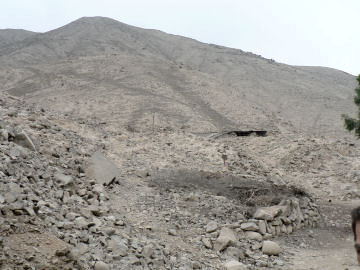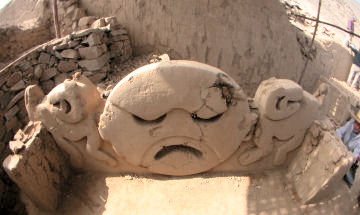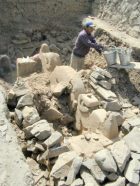Unearthing Ancient Astronomy
Researchers discover that ancient Peruvians were tracking the skies 4,000 years ago.
It looked like the surface of the moon.
All I could see was dirt and jagged gray rocks. There wasn’t a touch of green, much less homes or other buildings.
But I knew that I was looking at the remains of an ancient village in Peru—a village so sophisticated that it astounded the archaeologists who recently excavated part of the site. The scientists found that the village, called Buena Vista, contained artifacts that allowed its residents to track the seasons and predict the weather 4,000 years ago.
 |
|
Today, Buena Vista looks like a pile of dirt and rocks. Archaeologists covered the area they’d dug out to discourage looters. |
| David Hauer |
I visited Buena Vista during a recent trip to Peru. Since none of the ancient village is visible unless you know where to look, Hugo Ludeña, a Peruvian archaeologist working at the site, gave me a tour.
A fierce face
In one area, a metal trapdoor was fixed in the dirt. A worker opened the padlock to let me in. Sunlight poured through the opening, illuminating a mud staircase that led down to an underground chamber.
I walked down the stairs, pausing to allow my eyes to adjust to the dappled light.
I found myself staring at a huge face. It glared at me with scowling eyes. The head, flanked by two foxes, was at the center of a 20-foot-long mud sculpture.
 |
|
This 20-foot-long mud sculpture, called “The Menacing Disk,” directly faces the setting sun at winter solstice. |
| Robert Benfer |
The sculpture, which the archaeologists named the Menacing Disk, is 4,000 years old. It’s an amazing piece of ancient art, but it’s also more than that. Archaeologists who have studied the sculpture now know that it was part of a solar observatory. The people of Buena Vista used it to keep track of the seasons.
The clue that tipped them off was subtle. The sculpture is almost, but not quite, parallel with the wall behind it. One end of the sculpture is 3 inches farther from the wall than the other.
“That doesn’t happen by accident,” says archaeologist Robert Benfer of the University of Missouri–Columbia, the lead scientist at the site. In other buildings from that period, things such as walls and artworks were very carefully lined up with each other. The researchers figured that the sculpture had been placed in its odd position for a reason.
What are you looking at?
As they continued their research, the scientists discovered that the sculpture faced a 300-foot-long platform on the ridge of a mountain on the other side of the valley in which Buena Vista sits. The platform was covered in ash that had worked its way into the surrounding soil. To scientists, this suggested that fires, perhaps ceremonial ones, had once been set there.
The Buena Vista research team consulted an astronomer to find out whether the platform and the Menacing Disk had astronomical significance. They found out that it did. If someone stood in front of the disk and looked toward the platform on the shortest day of the year—the winter solstice—the setting sun would appear to sink into the platform.
The winter solstice was an important date for these ancient people. It marked the end of the harvest. Somewhat like Thanksgiving in the United States, it was a time of celebration.
The Temple of the Fox
The Menacing Disk wasn’t the only discovery of astronomical significance that archaeologists found at Buena Vista. Elsewhere at the site, atop a 33-foot-tall pyramid, they found a temple. In the entryway of the temple was a mural that showed a fox inside a llama. The researchers named this structure the Temple of the Fox.
Inside the temple, the archaeologists found bits of cotton and burned twigs, which they knew were the remains of ancient sacrifices. By testing the carbon in the cotton and twigs, they found that the temple was in use around 2200 BC.
“The Temple of the Fox is a place where people made payments to the earth, to make sure they would get a good crop,” Benfer says.
Inside the temple is a special chamber for offerings. The chamber’s doorway directly faces a large, carved rock on the horizon. The carving resembles a human face in profile. To someone who looked out of the chamber’s door on the summer solstice, which is the longest day of the year, the sun would appear to set behind the carved face. In Peru, that solstice is December 21.
That date was important to ancient farmers of this land. The area of Peru near Buena Vista receives almost no rainfall. Without rain, the farmers were entirely dependent on the river for water for their crops, which grew in the rich sediment laid down by yearly floods.
The farmers had to know when the floods were coming so that they would know when to plant their crops. December 21 was the date just before the floods occurred. By watching the sunset from the special chamber, they could tell when this date would arrive.
El Niño
However, the weather patterns aren’t always as predictable as the ancient farmers would have liked them to be. Every few years, a shift in winds and ocean currents in the Pacific causes a temporary change in the weather system. It’s called El Niño, and it can cause either terrible droughts or terrible floods.
El Niño has a powerful effect on animal life. Usually, sea animals stay near Peru’s coast all year long. But in an El Niño year, almost all the fishes, seals, and sea lions will have swum away from the coast by December 21. At Buena Vista, however, nothing would be out of the ordinary.
Benfer speculates that the temple priests, armed with the knowledge of the date from their astronomical observations, could have sent a runner down to the ocean on December 21 to check on the sea life. If the animals were gone, the priests would have known it was going to be a bad year, and the whole community could have planned for it.
The researchers believe that the entire community left the valley in bad years and went high into the mountains to plant their crops. Up there, fog provided moisture, and the river couldn’t reach their fields and houses, even if it flooded.
Burying the old
Around 1800 BC, the religion changed at Buena Vista. But the people didn’t want to destroy their temples. So they buried them under dirt and rocks, and then built new temples right on top.
Many times in the centuries after Buena Vista was no longer inhabited, looters raided the site, searching for treasure. They must have been disappointed. Despite their astronomical expertise, the ancient people of Buena Vista were mainly simple farmers. They hadn’t learned to make ceramics, much less to forge gold and silver, so they left few valuables behind for the looters to steal.
When Benfer and his team arrived in 2003, they started digging out the areas where the looters had been. They started here so that they could learn about the site without disturbing any areas that remained untouched.
Barely an inch below where the looters had stopped digging, the researchers discovered the roof of the Temple of the Fox.
 |
|
A worker digs out a sculpture at the ancient city of Buena Vista. |
| Robert Benfer |
Benfer’s team hated to damage the roof by digging into it. However, they knew if they didn’t, people from the villages nearby might break through it themselves in the hope of finding buried treasure. Therefore, the archaeologists carefully broke through the roof, examined the temple, and then painstakingly reburied it, protecting it for centuries to come.
That meant that when I visited it, all I could see of the Temple of the Fox was a slight indentation in the dirt and rocks where the scientists had done their work. I felt awed, knowing what that moonscape concealed.
Going Deeper:







